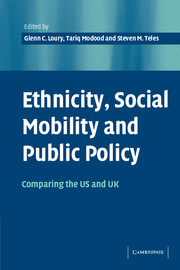Book contents
- Frontmatter
- Contents
- List of figures
- List of tables
- List of contributors
- Acknowledgements
- Introduction
- Part I Historical overviews
- Part II Informal social networks
- 4 Ethnicity as social capital: community-based institutions and embedded networks of social relations
- 5 Intergenerational mobility and racial inequality in education and earnings
- 6 Social integration and social mobility: spatial segregation and intermarriage of the Caribbean population in Britain
- 7 Ghettos and the transmission of ethnic capital
- 8 Family formulation in multicultural Britain: diversity and change
- Part III Formal structures
- Part IV Political institutions and processes
- Part V Normative analysis
- Author index
- Subject index
- References
4 - Ethnicity as social capital: community-based institutions and embedded networks of social relations
Published online by Cambridge University Press: 22 September 2009
- Frontmatter
- Contents
- List of figures
- List of tables
- List of contributors
- Acknowledgements
- Introduction
- Part I Historical overviews
- Part II Informal social networks
- 4 Ethnicity as social capital: community-based institutions and embedded networks of social relations
- 5 Intergenerational mobility and racial inequality in education and earnings
- 6 Social integration and social mobility: spatial segregation and intermarriage of the Caribbean population in Britain
- 7 Ghettos and the transmission of ethnic capital
- 8 Family formulation in multicultural Britain: diversity and change
- Part III Formal structures
- Part IV Political institutions and processes
- Part V Normative analysis
- Author index
- Subject index
- References
Summary
Past and recent studies have consistently found that ethnicity significantly affects varied outcomes of social mobility among different immigrant groups and that such divergent outcomes in turn lead to further changes in the character and salience of ethnicity. Much of the intellectual debate on ethnic differences is between the cultural perspective – emphasizing the role of internal agency and the extent to which ethnic cultures fit the requirements of the mainstream society – and the structural perspective – emphasizing the role of social structure and the extent to which ethnic groups are constrained by the broader stratification system and networks of social relations within that system.
Social scientists from both perspectives have attempted to develop statistical models to measure quantitatively the effects of “culture” and “structure” for the upward social mobility of immigrant groups. Under ideal circumstances, these models would include indicators illuminating pre-migration situations. But because of data limitations, many social scientists typically attempt to control for “structure” by documenting specific contexts of exit, identifying aspects of post-migration social structures, and operationalizing those components for which they have data. This is not only a conventional practice but also a reasonable approach, since many post-migration social structural differences (in the socioeconomic status of persons who came to the United States as adults) are likely to either reflect, or be carryovers from, pre-migration differences. However, even the most sophisticated statistical model accounts for only a proportion of the variance, leaving a large residual unexplained.
- Type
- Chapter
- Information
- Ethnicity, Social Mobility, and Public PolicyComparing the USA and UK, pp. 131 - 159Publisher: Cambridge University PressPrint publication year: 2005
References
- 87
- Cited by



